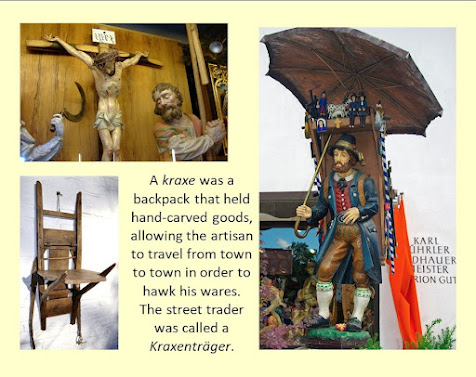By Kathy Kovach
Oberammergau, a Bavarian municipality so ancient there is no record of its founding, is simply believed to have Celtic origins. This small fairytale borough in the Alps has at least three claims to fame. Upon entering the streets, the first becomes apparent. Nearly every building, be it a place of business, a church, or a home, has beautiful fresco artwork adorning the exterior walls. Each illustrates a story, whether it be from a Brothers Grimm fable such as “Little Red Riding Hood” or a religious tale depicting the crucifixion and resurrection of Jesus Christ. The entire town is an art museum where one simply doesn’t know where to fix their gaze.
 |
| Little Red Riding Hood house |
Some artwork is elaborate, using the entire wall as a canvas. Only the wealthy could afford such opulence. In other cases, just the windows are adorned indicating someone of more modest means.
 |
| Simple fescue |
This fresco technique, dating back to the 1700s, is common in Southern Germany and Austria and is known as Lüftlmalerei. The artist most notably recognized with the style is Franz Seraph Zwinck. Water based paint was applied to freshly laid plaster, which created a chemical reaction that caused the image to become part of the wall itself. As a result, many of the images have remained vibrant to this day.
As if being surrounded by an art museum isn’t enough, the town is also known for its beautiful wood crafting. Centuries ago, farmers needed to come up with another way to earn income during the harsh Bavarian winters. With ample linden and alder trees growing in the surrounding forest, many took up wood carving. These often depicted a religious theme or could also be whimsical trinkets or toys. Eventually, Oberammergau became renowned for the excellent artistry of wood carving, even establishing a trade school 150 years ago dedicated to the craft. Street traders expanded to the rest of Europe carrying the items on their backs in a kraxe, a type of wooden backpack. By the 18th and 19th centuries, many of the locals left the village and opened their own shops.
Oberammergau is my favorite tourist stop because of the artisanship literally around every corner. One last element to mention, however, is one I’ve regretted not to have taken part in. A mere 300 miles from our home at Rhein-Main Air Force Base in Frankfurt, the world-famous Passion Play was right at our fingertips in 1980. However, due to circumstances beyond our control—a new baby for one, toddler for two—we felt it best not to subject our little family to a five-hour presentation, including a three-hour dinner break in the middle.
 |
| Passion Play |
The origin of the sacred play is dark. In the midst of the Thirty Years War (1618-1648), the bubonic plague reared its ugly head and swept through Europe like a dry grass fire. Oberammergau had been spared until 1632. According to legend, they had imposed a quarantine over the town, but one person broke it and left, only to return unknowingly carrying the disease with him. More than eighty people died over the next ten months, devastating the small population. The villagers then vowed to put on the Passion Play—a depiction of Jesus’s last week on earth including the resurrection and transfiguration—every ten years if the Lord would spare them from the plague.
.png) |
| Bubonic plague doctor |
True to their word, the play was performed every decade from 1634 to 1674, then moving to 1680 and each subsequent decade ending with a zero after that. The first few performances were held in the graveyard where the victims were buried. Legend has it that the plague, known as the Black Death, never touched them after that. For nearly 400 years, the villagers have fulfilled their promise.
The following short video was taken by a tourist walking through Oberammergau. They also visit the neighboring monastery, Ettal, which I had blogged about in April. You can read that article here. Note that the play took place last year in 2022, missing the decadal date of 2020 due to the coronavirus pandemic. It has only been canceled or postponed seven times since its conception.
From frescoes to wood carvings to performing arts, tiny Oberammergau has been a creative force for centuries. A true living fairytale.
A TIME-SLIP NOVEL
A secret. A key. Much was buried on the Titanic, but now it's time for resurrection.
To buy: Amazon





Thank you for posting today! There is nothing to say but "wow"!
ReplyDelete